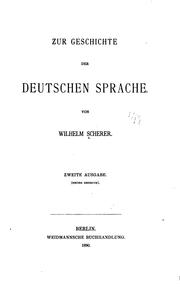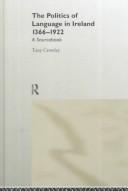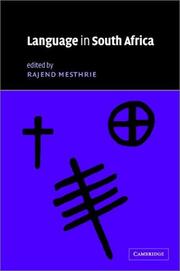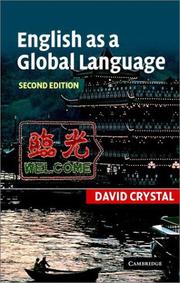| Listing 1 - 10 of 11 | << page >> |
Sort by
|

ISSN: 03040712 ISBN: 902721994X 1556197705 9786613720856 1280879548 9027276544 9789027276544 Year: 1995 Volume: v. 16 Publisher: Amsterdam/Philadelphia John Benjamins Pub. Co.
Abstract | Keywords | Export | Availability | Bookmark
 Loading...
Loading...Choose an application
- Reference Manager
- EndNote
- RefWorks (Direct export to RefWorks)
Wilhelm Scherer (1841-1886) has gained wide recognition for his extraordinary accomplishments in linguistics as well as in literary studies.His first and most important contribution to the development of linguistic science was his monumental work of 508 pages Zur Geschichte der deutschen Sprache, published in 1868.His stated objective was "to subject all aspects of the Germanic grammar to a new treatment." While such a wording sounds rather modest, the actual implementation in his book, if viewed within the framework of his time, might very appropriately be called revolution
Book
Abstract | Keywords | Export | Availability | Bookmark
 Loading...
Loading...Choose an application
- Reference Manager
- EndNote
- RefWorks (Direct export to RefWorks)
Dieser Band ist Volkmar Lehmann zum 60. Geburtstag gewidmet. Gleichzeitig bietet uns das Buch die Gelegenheit, eine kleine Zusammenschau der Arbeiten des Jubilars vorzustellen und unsere Wertschätzung dieser Werke auszudrücken, indem jeder der Artikel eine These von Volkmar Lehmann aufgreift. Einen inhaltlichen Zusammenhang erhalten die hier versammelten Artikel auch dadurch, dass in ihnen die Frage der sprachlichen Entwicklung eine Rolle spielt. Mit dem Titel "Entwicklungen in Slavischen Sprachen 2" knüpft man gleichzeitig an einen vorausgegangenen Sammelband des gleichen Titels an. Während im ersten Band jedoch Artikel zu diachronen Fragestellungen zusammengefasst sind, geht es hier um eine breitere Auffassung des Entwicklungsbegriffs.
linguistic development --- Anstatt --- Diachronie --- Entwicklungen --- Geburtstag --- Lehmann --- Linguistik --- Objektsprache --- Schülerinnen --- Schülern --- seinen --- Slavische Sprachwissenschaft --- Slavischen --- Sprachen --- sprachliche Funktionen --- Volkmar

ISBN: 9027251932 1588115186 1423772334 9786612254994 1282254995 902729545X 9781423772330 9789027251930 9781588115188 Year: 2004 Volume: 57 Publisher: Amsterdam Benjamins
Abstract | Keywords | Export | Availability | Bookmark
 Loading...
Loading...Choose an application
- Reference Manager
- EndNote
- RefWorks (Direct export to RefWorks)
Wolfgang Wildgen presents three perspectives on the evolution of language as a key element in the evolution of mankind in terms of the development of human symbol use. (1) He approaches this question by constructing possible scenarios in which mechanisms necessary for symbolic behavior could have developed, on the basis of the state of the art in evolutionary anthropology and genetics. (2) Non-linguistic symbolic behavior such as cave art is investigated as an important clue to the developmental background to the origin of language. Creativity and innovation and a population's ability to integrate individual experiments are considered with regard to historical examples of symbolic creativity in the visual arts and natural sciences. (3) Probable linguistic 'fossils' of such linguistic innovations are examined. The results of this study allow for new proposals for a 'protolanguage' and for a theory of language within a broader philosophical and semiotic framework, and raises interesting questions as to human consciousness, universal grammar, and linguistic methodology. (Series B).
Language and languages --- Origin. --- Historical linguistics --- Sociolinguistics --- #KVHA:Diachronie --- Origin of languages --- Speech --- Origin --- Historical linguistics. --- Diachronic linguistics --- Dynamic linguistics --- Evolutionary linguistics --- Language and history --- Linguistics --- History --- Langage --- Origines.
Book
ISSN: 27407624 ISBN: 9782356681690 9782356680730 2356681698 235668073X Year: 2021 Publisher: MOM,
Abstract | Keywords | Export | Availability | Bookmark
 Loading...
Loading...Choose an application
- Reference Manager
- EndNote
- RefWorks (Direct export to RefWorks)
Les treize études réunies dans ce volume sont consacrées au phénomène de la dérivation depuis l’indo-européen (sanskrit védique, tokharien, vieux norrois, vieux slave, grec ancien, latin) jusqu’à nos langues modernes. Les contributions réunies ici proposent, pour une part d’entre elles, de nouvelles hypothèses sur l’origine de certains suffixes, tandis que d’autres exposent les résultats de leurs évolutions et leur productivité. Les observations synchroniques et diachroniques sur le comportement suffixal concernent à la fois la sémantique, la question du développement du vocabulaire spécialisé et celle de leur rôle proprement grammatical, en particulier le rapport entre adjectif et substantif. Une contribution centrée sur l’accentuation forme la conclusion de l’ensemble. The thirteen papers brought together in this volume are devoted to the phenomenon of derivation from Indo-European (Vedic Sanskrit, Tokharian, Old Norse, Old Slavic, Ancient Greek, Latin) up to our modern languages. The contributions gathered here offer, for a part of them, new hypotheses on the origin of certain suffixes, while others expose the results of their evolutions and their productivity. Synchronic and diachronic observations on suffixal behavior concern semantics, the question of the development of specialized vocabulary and that of their strictly grammatical role, in particular the relationship between adjective and substantive. A contribution focused on the accent concludes the volume.
E-books --- Indo-European languages --- Linguistics --- accent --- dérivation nominale --- diachronie --- grammaticalisation --- innovation --- morphologie --- proto-indo-européen --- renouvellement --- sémantique --- synchronie --- toponymie --- nominal derivation --- diachronic --- grammaticalization --- morphology --- Proto-Indo-European --- semantics --- synchronic --- toponym
Book
ISBN: 9053562346 9789053562345 Year: 1997 Publisher: Amsterdam Amsterdam University Press
Abstract | Keywords | Export | Availability | Bookmark
 Loading...
Loading...Choose an application
- Reference Manager
- EndNote
- RefWorks (Direct export to RefWorks)
Nederlands --- Dutch language --- geschiedenis --- Historical linguistics --- History. --- 803.93-02 --- 803.93 --- #A9806A --- #KVHA:Diachronie; Nederlands --- * 834 --- Geschiedenis --- Nederlandse taal --- -Flemish language --- Netherlandic language --- Germanic languages --- Nederlands. Nederlandse taalkunde--?-02 --- Nederlands - geschiedenis van de taal --- History --- -Nederlands. Nederlandse taalkunde--?-02 --- geschiedenis. --- 803.93-02 Nederlands. Nederlandse taalkunde--?-02 --- Dutch language - History. --- NEERLANDAIS (LANGUE) --- HISTOIRE --- INTRODUCTION

ISBN: 0415157188 041515717X 1134729022 1280105186 0203005929 9780203005927 9780415157179 9780415157186 1134729014 9781134729012 9781134729029 9781280105180 Year: 2000 Publisher: London New York Routledge
Abstract | Keywords | Export | Availability | Bookmark
 Loading...
Loading...Choose an application
- Reference Manager
- EndNote
- RefWorks (Direct export to RefWorks)
Providing direct access to original texts, this is an historical resource book which can be used as a case study in the relations between language and cultural identity.
English language --- Irish language --- Language policy --- #KVHA:Diachronie; Engels --- #KVHA:Taalpolitiek; Ierland --- Glottopolitics --- Institutional linguistics --- Language and languages --- Language and state --- Languages, National --- Languages, Official --- National languages --- Official languages --- State and language --- Communication policy --- Language planning --- Erse language --- Gaelic language, Irish --- Irish Gaelic language --- Goidelic languages --- Germanic languages --- Political aspects --- History --- Government policy --- Ireland --- Irish Free State --- Politics and government --- POLITIQUE LINGUISTIQUE --- IRLANDE
Book
ISBN: 9782869062641 2869062648 2869065604 Year: 2011 Publisher: Tours Presses Universitaires François-Rabelais
Abstract | Keywords | Export | Availability | Bookmark
 Loading...
Loading...Choose an application
- Reference Manager
- EndNote
- RefWorks (Direct export to RefWorks)
Dans le cadre des rapports transversaux entre les sphères linguistiques germanophone et francophone en Europe, les conditions et les pratiques de la traduction, envisagées dans une perspective diachronique, sont enrichies, dans la lignée du spatial turn des études culturelles, par le facteur espace, afin de montrer ou d’interroger la coïncidence entre la circulation des personnes et des textes. Dans quels cas, dans quelles périodes historiques en particulier le déplacement des hommes favorise-t-il la prise en compte de l’étranger ? Quel est le lien avec la traduction ? Quelles sont les différences dans la position sociale et institutionnelle du traducteur d’une ère culturelle à l’autre ? Y a-t-il des lieux spécifiques de la traduction ? Traduction et histoire mettent-ils en jeu des transferts binaires, triangulaires ? La réflexion s’inscrit globalement dans un temps long, allant du Moyen Âge à nos jours, la période du xviiie au xxe siècle étant cependant privilégiée, et certains moments clés comme la Révolution française, l’entre-deuxguerres (pour les exilés allemands) et la période de l’Occupation, étant cruciaux.
Migration. Refugees --- German literature --- French literature --- anno 1700-1799 --- anno 1800-1999 --- Traduction --- Écrivains exilés --- Littérature d'exil --- Écrits d'immigrés --- Littérature --- Communication interculturelle --- Actes de congrès. --- Littérature --- History --- Literary Theory & Criticism --- traduction --- poésie --- entre-deux-guerres --- migration --- Révolution française --- linguistique --- littérature --- émigration --- diachronie

ISBN: 1107129621 1280429941 051117778X 0511041160 0511148208 0511305214 0511486693 0511046731 9780511041167 9780511046735 9780521791052 0521791057 9780511486692 9781280429941 9786610429943 6610429944 052153383X 9780521533836 9780511177781 9780511148200 9780511305214 9781107129627 Year: 2002 Publisher: Cambridge, U.K. New York Cambridge University Press
Abstract | Keywords | Export | Availability | Bookmark
 Loading...
Loading...Choose an application
- Reference Manager
- EndNote
- RefWorks (Direct export to RefWorks)
This is a comprehensive and wide-ranging 2002 guide to language and society in South Africa. As the authors demonstrate, the South African context offers a treasure trove of data and examples for linguistic and sociolinguistic study. The book surveys the most important language groupings in the region in terms of pre-colonial and colonial history; contact between the different language varieties, leading to language loss, pidginization, creolization and new mixed varieties; language and public policy issues associated with the transition to a post-apartheid society and its eleven official languages. It details the history of indigenous languages, the impact of European languages upon them, and of transformations to the European languages themselves. Written by a team of leading researchers, all the chapters are informed by the importance of socio-political history in understanding questions of language. The book will be welcomed by students and researchers in language and linguistics, sociology, anthropology and social history.
Sociolinguistics --- Language and culture --- Language policy --- Language planning --- Language and languages --- Planned language change --- Culture and language --- Culture --- Language and society --- Society and language --- Sociology of language --- Linguistics --- Sociology --- Integrational linguistics (Oxford school) --- Planning --- Social aspects --- Sociological aspects --- South Africa --- Languages. --- #KVHA:Diachronie; Engels --- #KVHA:Taal; Zuid-Afrika --- Arts and Humanities --- Language & Linguistics --- Communication policy

ISBN: 1107136970 0511078625 1280415339 0511179138 0511203055 0511326068 0511486995 051107705X 9780511078620 0511075510 9780511075513 9780511077050 9780511326066 9780511203053 9786610415335 6610415331 9781139196970 1139196979 9780521823470 0521823471 9780521530323 0521530326 3125335795 9783125335790 1107611806 9781107611801 9780511486999 0521823471 0521530326 9781107611801 Year: 2003 Publisher: Cambridge Cambridge University Press
Abstract | Keywords | Export | Availability | Bookmark
 Loading...
Loading...Choose an application
- Reference Manager
- EndNote
- RefWorks (Direct export to RefWorks)
David Crystal, world authority on the English language, presents a lively and factual account of the rise of English as a global language and explores the whys and wherefores of the history, current status and future potential of English as the international language of communication. English has been lauded as the most 'successful' language ever, with 1,500 million speakers worldwide; but Crystal avoids taking sides and tells the story in a measured but engaging way, backed by facts and figures. This new edition of his classic book includes new material (on the vocabulary, grammar and pronunciation of New Englishes), footnotes, new tables, and a full bibliography. There are updates throughout. This is a book for anyone of any nationality concerned with English: teachers, students, language professionals, politicians, general readers and anyone with a love of the language.
English language --- Communication, International. --- Language, Universal. --- Interlinguistics --- International language --- Language, International --- Language, World --- Universal language --- World language --- International communication --- World communication --- Communication --- Germanic languages --- English language in foreign countries --- World Englishes --- Social aspects --- Communication, International --- Language, Universal --- 802.0 <100> --- 802.0 <100> Engels. Engelse taalkunde--Wereld. Internationaal. Alle landen gezamenlijk --- Engels. Engelse taalkunde--Wereld. Internationaal. Alle landen gezamenlijk --- #KVHA:Diachronie; Engels --- Sociolinguistics --- Foreign countries --- Communication [International ] --- Intercultural communication --- Language [Universal ] --- English-speaking countries --- Arts and Humanities --- Language & Linguistics

ISBN: 2735102084 2735125653 9782735102082 Year: 2021 Volume: 9 Publisher: Paris : Éditions de la Maison des sciences de l’homme,
Abstract | Keywords | Export | Availability | Bookmark
 Loading...
Loading...Choose an application
- Reference Manager
- EndNote
- RefWorks (Direct export to RefWorks)
Norbert Aujoulat est responsable du département d’art pariétal au Centre National de la préhistoire à Périgueux (ministère de la Culture et de la Communication/ sous-direction de l’Archéologie). L’analyse descriptive d’une peinture ou d’une gravure préhistorique reposant en partie sur sa reproduction, le transfert de l’image implique donc une méthodologie spécifique et un matériel parfaitement adapté. Ce travail est à la fois une synthèse des travaux antérieurs relatifs aux techniques de relevé et le résultat de plusieurs années de recherches personnelles concernant en particulier l’enregistrement photographique des données et leur traitement en laboratoire par ordinateur. Conçu dans un esprit très didactique, il se présente comme un véritable manuel, indispensable à toute recherche dans le domaine de l’art pariétal. Norbert Aujoulat is head of the cave art section at the National Prehistory Centre in Perigueux (Ministry of Culture and Communication/Department of Archaeology). The descriptive analysis of a prehistoric painting or engraving depends, to a great extent, on its reproduction, which, in its turn, depends on a specific methodology and appropriate material. This book is a synthesis of earlier work dealing with reproduction techniques and is also the result of several years of personal research into the photographic recording of data and their Processing by computer in the laboratory. Highly didactic, it is intended as a practical manual, indispensable for any research in the field of cave art.
Cave paintings --- Archaeology --- Paleolithic period --- Art rupestre --- Archéologie --- Paléolithique --- Methodology --- Méthodologie --- Photography in archaeology --- Rock paintings --- Petroglyphs --- France --- Antiquities --- -Rock paintings --- -Petroglyphs --- -Carvings, Rock --- Engravings, Rock --- Rock carvings --- Rock engravings --- Rock inscriptions --- Stone inscriptions --- Inscriptions --- Picture-writing --- Paintings, Rock --- Pictured rocks --- Rock drawings --- Art, Prehistoric --- Painting, Prehistoric --- Archeology --- Anthropology --- Auxiliary sciences of history --- History --- Antiquities. --- Photography in archaeology. --- Methodology. --- -Methodology --- Archéologie --- Paléolithique --- Méthodologie --- Carvings, Rock --- Archaeology - Methodology --- Rock paintings - France --- Petroglyphs - France --- France - Antiquities --- méthodologie --- diachronie --- manuel --- relevé --- grotte de Lascaux --- œuvre pariétale --- colorimétrie --- donnée morphochromatique --- traitement des données --- fac-similé --- Lascaux II
| Listing 1 - 10 of 11 | << page >> |
Sort by
|

 Search
Search Feedback
Feedback About UniCat
About UniCat  Help
Help News
News